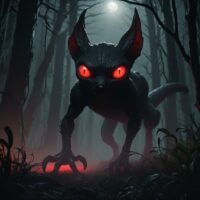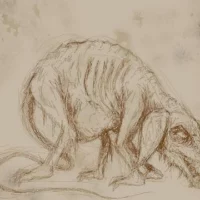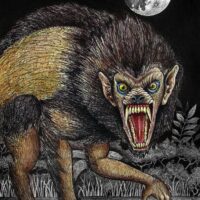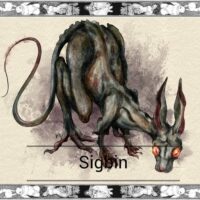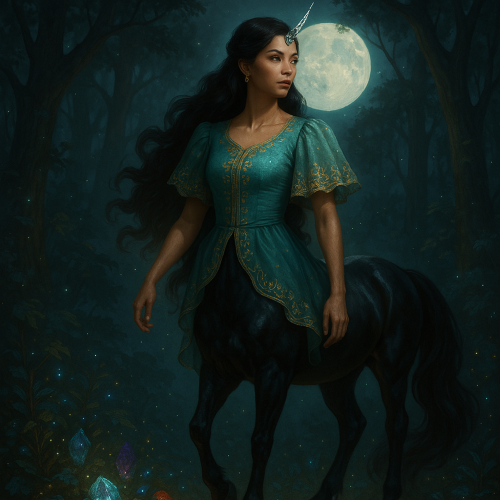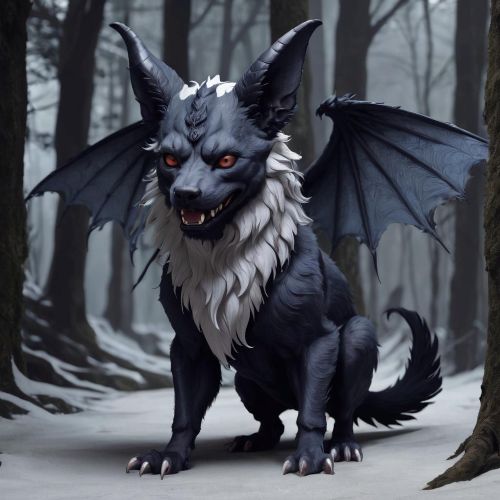Sigbin : The Filipino Werewolf
Listen
At a glance
| Description | |
|---|---|
| Origin | Philippine Mythology |
| Classification | Hybrids |
| Family Members | N/A |
| Region | Philippines |
| Associated With | Shapeshifting, Blood Sucking |
Sigbin
Introduction
In Philippine mythology, the Sigbin is a captivating and enigmatic figure, shrouded in mystery and fear. With an appearance that evokes comparisons to Western vampires and werewolves, it remains distinctly rooted in Filipino cultural lore. This creature thrives in the shadows of folklore, giving rise to stories about its nocturnal escapades and unusual behaviors. The Sigbin embodies a complex blend of dread and intrigue, playing a significant role in the Philippines’ cultural narrative.
Often linked to the occult and dark themes, the Sigbin reflects the fears and superstitions of various Filipino communities. It serves as both a cautionary symbol and an intriguing character within the rich tapestry of local myths. Legends suggest that the Sigbin emerges from darkness, embodying the delicate balance between the ordinary and the supernatural in Filipino life.
Physical Traits
The Sigbin’s appearance is subject to regional variations, yet certain features remain consistent. Generally, it resembles a peculiar creature with canine traits, characterized by backward-facing feet that allow it to walk in a crouched position. Its large, flapping ears and long, whip-like tail, which it can wield as a weapon, further contribute to its unsettling presence. Often depicted with glowing red or green eyes, the Sigbin is said to possess the ability to hypnotize or paralyze its prey. Adding to its fearsome reputation, it reportedly emits a foul odor that can incapacitate those who catch a whiff.
In terms of shape and size, the Sigbin is commonly portrayed as a small, goat-like entity but can also appear in human-like or monstrous hybrid forms, showcasing a blend of characteristics. It features elongated limbs and a bat-like appearance, equipped with claws suited for both movement and hunting. One of its most striking attributes is its oversized head, resembling that of a dog or goat, which is juxtaposed with a relatively small body, enhancing its eerie aura.
Family
The Sigbin is frequently connected to other mythical beings in Philippine folklore, particularly the Aswang, a term that encompasses various malevolent creatures often depicted as shape-shifters. These entities inhabit a shared mythological realm filled with supernatural figures coexisting alongside humans. In some tales, the Sigbin is described as the offspring or servant of the Aswang, further emphasizing its sinister traits. This intricate network of relationships among these beings highlights the cultural importance of the Sigbin within the broader storytelling tradition.
The origins of the Sigbin are as mysterious as the creature itself. Some legends suggest that Sigbins are born to human parents who engage in witchcraft or form pacts with dark spirits. Other narratives propose that the Sigbin is a unique supernatural being, existing in a hidden, shadowy dimension parallel to the human world. While there isn’t a unified account of Sigbin familial structures, some stories indicate that these creatures may gather in small groups, heightening their menace to isolated communities.
Across the Philippines, the Sigbin is recognized by a variety of names, each reflecting the linguistic diversity and cultural nuances of the regions. For example, it may be referred to as Siban, a local dialect variation. The term Sigbinan is also used in some narratives to describe the creature’s dwelling or nesting place.
Other Names
The Sigbin shares its legendary status with several other names. Amamayong is used in certain areas to refer to similar beings that possess slightly different characteristics. The term Balbal can sometimes be used interchangeably with Sigbin, although it more commonly denotes a different type of ghoul. Another related creature, Wak-Wak, is a nocturnal entity that shares similarities with the Sigbin, particularly in its fearsome reputation.
Powers and Abilities
The Sigbin is endowed with various supernatural powers that contribute to its mysterious status in folklore. One of its most notable abilities is shape-shifting, allowing it to transform into seemingly harmless creatures to deceive its victims and avoid detection. This cunning tactic is reminiscent of the Aswang, further enhancing the Sigbin’s reputation for trickery.
The creature is also believed to possess exceptional night vision, as suggested by its glowing eyes, enabling it to navigate and hunt effectively in the darkness. Intelligence plays a significant role in the Sigbin’s lore; folktales often portray it as a clever being that can outsmart humans, using cunning strategies to capture prey or escape from danger.
Moreover, the Sigbin is said to exert a spiritual influence, with the power to inflict illness or misfortune on individuals and communities. This malevolence adds to its fearsome image, establishing the Sigbin as a figure that embodies dread and uncertainty. Its agility and speed further enhance its elusive nature, while some accounts claim it can become invisible, making it nearly impossible to capture. Ultimately, these abilities solidify the Sigbin’s role as a harbinger of doom in Philippine mythology.
Modern Day Influence
In modern culture, the Sigbin continues to hold a significant place, influencing a variety of artistic expressions and popular media. This enigmatic creature appears in literature, where authors merge traditional myths with contemporary storytelling techniques. It can be found in short stories, novels, and even children’s books, often serving as a metaphor for societal issues, fears, or moral lessons. By weaving the Sigbin into narratives, writers keep its legacy alive while inviting new interpretations that resonate with today’s readers.
The Sigbin’s presence is also felt in film and television, particularly within the horror genre. Numerous adaptations depict the creature’s terrifying traits, amplifying its fearsome reputation through modern cinematic techniques. This connection between traditional beliefs and contemporary storytelling captivates audiences, bridging the gap between ancient folklore and modern entertainment. Additionally, the Sigbin has inspired a range of merchandise, from toys to clothing, showcasing its relevance and appeal in Filipino culture.
Cultural festivals further highlight the Sigbin’s enduring legacy, as some local celebrations incorporate mythical creatures into their festivities, underscoring the significance of folk narratives in shaping cultural identity. Despite advancements in technology and societal changes, the Sigbin remains a popular figure in contemporary folklore, often invoked to explain unexplained phenomena or as a cautionary tale for children. This powerful symbol encapsulates the darker aspects of existence, ensuring its place in the rich tapestry of Philippine mythology while captivating and terrifying new generations.
Related Images
Sources
Aswang Project. (n.d.). The Sigbin: The mysterious goat-like creature of Philippine folklore. The Aswang Project. Retrieved November 1, 2025, from https://www.aswangproject.com/sigbin/
Demetrio, F. R. (1991). Encyclopedia of Philippine folk beliefs and customs (Vols. 1–2). Xavier University Press.
Eugenio, D. L. (2007). Philippine folk literature: An anthology (2nd ed.). University of the Philippines Press.
Fansler, D. S. (1921). Filipino popular tales. American Folklore Society.
Paraiso, S., & Paraiso, J. J. (2003). The Balete book: A collection of demons, monsters, elves and dwarfs from the Philippine lower mythology. Giraffe Books.
Ramos, M. D. (1971). The creatures of Philippine lower mythology. University of the Philippines Press.
Ramos, M. D. (1990). The creatures of midnight: Mythical beings from Philippine folklore. CreateSpace Independent Publishing Platform.
PHSpirits. (n.d.). Sigbin. PHSpirits. Retrieved November 1, 2025, from https://phspirits.com/sigbin/
Mythus Wiki. (n.d.). Sigbin. Myth and Folklore Wiki. Retrieved November 1, 2025, from https://mythus.fandom.com/wiki/Sigbin
Wikipedia. (n.d.). Sigbin. Wikipedia. Retrieved November 1, 2025, from https://en.wikipedia.org/wiki/Sigbin
Frequently Asked Questions
What powers does the Sigbin have?
The Sigbin is said to possess numerous supernatural abilities. It can become invisible, shape-shift into human form, and move with extraordinary speed. Folklore also claims it can drain energy from people’s shadows or cause illness and misfortune to those it targets. Some stories even say the Sigbin collects human hearts to create magical amulets, giving rise to its reputation as both a physical and spiritual predator.
What is the Sigbin in Philippine mythology?
The Sigbin is a mysterious creature from Philippine folklore often described as a goat- or dog-like being that walks backwards with its head lowered between its legs. It is said to come out at night to suck the blood of its victims, usually from their shadows or hearts. Some versions claim that the Sigbin serves the Aswang, while others describe it as a unique supernatural species with its own dark powers.
What does the Sigbin look like?
Descriptions of the Sigbin vary by region, but most accounts agree that it has large ears that flap like bat wings, glowing red or green eyes, and a whip-like tail it uses as a weapon. It often emits a foul odor and has backward-facing feet, allowing it to move stealthily and confuse pursuers. Its disturbing, crouched posture and animal-human hybrid features make it one of the most terrifying creatures in Philippine mythology.
Is the Sigbin related to the Aswang?
Yes, the Sigbin is frequently associated with the Aswang, a broader category of shape-shifting monsters in Filipino folklore. Some legends describe the Sigbin as a servant or companion of the Aswang, helping it hunt for victims. In other tales, the Sigbin acts independently, preying on humans or animals under the cover of darkness. This connection emphasizes the shared themes of deception, predation, and fear that unite these mythic beings.
Does the Sigbin still appear in modern Filipino culture?
Yes, the Sigbin remains a prominent figure in modern Philippine culture. It often appears in horror films, comics, and novels as a symbol of fear and the unknown. The creature is also referenced in children’s stories, folk festivals, and online discussions about mythology. Through its adaptability, the Sigbin continues to represent the balance between folklore, morality, and mystery within Filipino identity.


